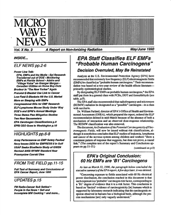News & Comment
Consistent with Higher Tumor Counts
20 Years After Landmark Lai-Singh Study
Tuesday, September 6, 2016
Last updated October 22, 2019
An Insider Unafraid To Challenge the Microwave Orthodoxy

Thursday, July 14, 2016
Last updated July 17, 2016
Ron Melnick Corrects ‘Misinformation,’
Rebuffed by the New York Times
Friday, June 10, 2016
Are More People Getting Brain Tumors?
GBMs, the Most Virulent Type, Are Rising

Tuesday, May 31, 2016
Last updated June 2, 2016
U.S. Government Expected To Advise Public of Health Risk
Wednesday, May 25, 2016

